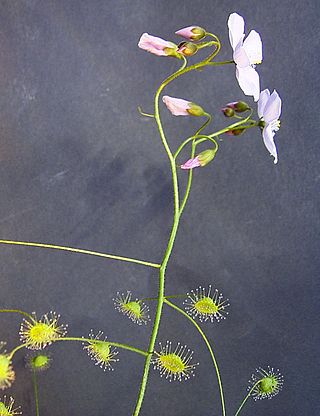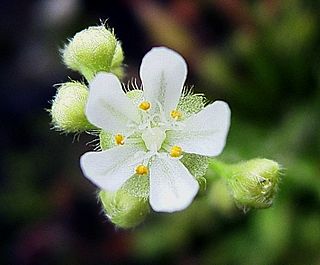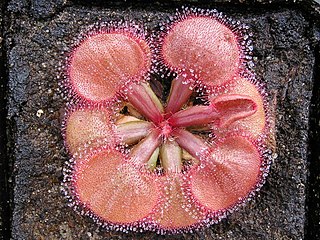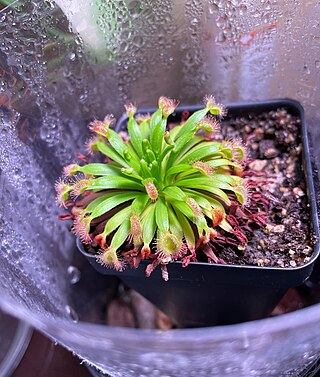
Drosera banksii, commonly known as Banks' sundew, is a small annual species in the carnivorous plant genus Drosera. The reniform-shaped leaves are attached to petioles and arranged in a circular pattern (rosette) around the stem. The 5 mm wide flowers are white. It is native to northern Australia and Southeast Asia. D. banksii was originally described by Robert Brown and validly published by Augustin Pyramus de Candolle in 1824. It is currently classified in the subgenus Lasiocephala, but expert opinion is that it is misplaced and should be reclassified with the closely allied D. subtilis.

Drosera bicolor is an erect perennial tuberous species in the genus Drosera that is endemic to Western Australia. It produces a basal rosette of leaves similar to that of D. peltata and the stem grows to 11 cm (4 in) high. Its white flowers that have a red spot near the petal base emerge from September to October. D. bicolor grows in deep silica sand on heathland along the upper Phillips River and south-east of Lake King.

Drosera gigantea, the giant sundew, is an erect perennial tuberous species in the carnivorous plant genus Drosera that is endemic to Western Australia. It grows in sandy soils at the margins of swamps and near granite outcrops along the Western Australian coast from Albany north to just south of Geraldton. D. gigantea produces small shield-shaped leaves along many lateral branches that look like a small tree. Individual plants can grow up to 0.2–1 m (0.7–3.3 ft) tall. Because of its tall, tree-like form, it is considered one of the largest Drosera species. It is also easily cultivated and enjoys damp, humid conditions often provided in greenhouses. White flowers emerge from August to November. The red tubers of this species can grow to be 3.8 cm (1.5 in) in diameter and may be a metre below ground.

Drosera macrantha, the bridal rainbow, is a scrambling or climbing perennial tuberous species in the carnivorous plant genus Drosera that is endemic to Western Australia. It grows in a variety of habitats, including winter-wet depressions in sandy, loamy, laterite, or quartzite soils. D. macrantha produces small, cup-shaped carnivorous leaves along a long stem that can be 0.16–1.5 m (0.5–4.9 ft) high as it climbs. Its 1 in (2.5 cm) white or pink flowers emerge from June to November, blooming earlier in the more northern range.
Drosera moorei is a scrambling or climbing perennial tuberous species in the carnivorous plant genus Drosera. It is endemic to Western Australia and grows near granite outcrops in sandy loam. D. moorei produces small, circular, peltate carnivorous leaves along glabrous stems that can be 12–35 cm (5–14 in) long. Inflorescences have two to ten yellow flowers and bloom from September to October.
Drosera salina is an erect perennial tuberous species in the carnivorous plant genus Drosera. It is endemic to Western Australia and is only found in salt-free sand on the margins of salt lakes in a few locations north of Albany east to north-west of Esperance. The specific epithet, salina, refers to the salt lake margins that this species inhabits. D. salina produces small carnivorous leaves along stems that can be 7 cm (3 in) high. White flowers bloom from July to September.

Drosera stricticaulis, the erect sundew, is an erect perennial tuberous species in the carnivorous plant genus Drosera. It is endemic to Western Australia and is found near watercourses and granite outcrops in sandy clay or loam. D. stricticaulis produces small, cup-shaped carnivorous leaves along green, glandular stems that can be 25 cm (10 in) high. Pink flowers bloom from July to October.
Drosera subtilis is an erect annual species in the carnivorous plant genus Drosera. It is native to northern Western Australia and a single site in the Northern Territory. In Western Australia, it has been collected from Beverley Springs Station, Bigge Island, and the Mitchell Plateau area all in the vicinity of the Kimberley region. In the Northern Territory, it has been found near Little Nourlangie Rock. It grows over sandstone near seepage margins in skeletal sandstone sand and black humus mixed soils. D. subtilis is anchored to the soil by a system of thin, fleshy roots and it lacks a tuber. It produces small carnivorous leaves along erect, reddish stems that can be 20 cm (8 in) high.

Drosera subg. Thelocalyx is a subgenus of two species in the genus Drosera.

Drosera hamiltonii, the rosy sundew, is a small, compact species in the carnivorous plant genus Drosera and is the only species in the monotypic subgenus Stelogyne. The glandular leaves are about 2 cm (0.8 in) long and arranged in a rosette. In November and December, pink flowers on 30 cm (12 in) tall scapes bloom. It is endemic to coastal swamps in south-west Western Australia. It was first described by Cecil Rollo Payton Andrews in 1903 and placed in section Stelogyne as the only species by Ludwig Diels in 1906. In 1994, Rüdiger Seine and Wilhelm Barthlott suggested D. hamiltonii belonged in their section Drosera, reducing section Stelogyne to synonymy with section Drosera. In 1996, Jan Schlauer revised the genus classification and elevated section Stelogyne to a subgenus, arguing that the unique fused styles requires segregation at more than a sectional rank.

Drosera glanduligera, commonly known as the pimpernel sundew or scarlet sundew, is a species of carnivorous plant endemic to southern Australia. It is an ephemeral annual plant that grows in the winter and flowers from August to November.

Drosera derbyensis is a perennial carnivorous plant in the genus Drosera and is endemic to Western Australia. Its erect or semi-erect leaves are arranged in a rosette with one or more rosettes emerging from the root stock. The petioles are narrowly oblanceolate, 0.8–1.0 mm wide at the proximate end and 1.3–1.7 mm wide at the apex(wiki), narrowing to 0.5–0.7 mm at the laminar base. The petioles are frequently 35–45 mm long when the plant is in flower and are covered in white woolly non-dendritic hairs. The insect-trapping leaf lamina is orbicular and much shorter than the petioles at only 2–3 mm in diameter. The laminar adaxial surface is covered in insect-trapping glands. Each rosette produces 1–4 raceme inflorescences, which are 25–35 cm (10–14 in) long. Each inflorescence bears 30–50 white flowers, with flowering occurring from March to June. The upper portion of the scape and the abaxial surface of the sepals are covered with white woolly non-dendritic hairs. Its roots are fibrous. Drosera derbyensis grows in sandy soils in floodways or near rock outcrops from Derby to Beverley Springs in the Kimberley region.

Drosera dilatato-petiolaris is a carnivorous plant in the genus Drosera and is endemic to Australia, being found in both Western Australia and the Northern Territory. Its leaves are arranged in a rosette and commonly produces plantlets, eventually forming large clumps that can be over 1 ft (0.3 m) across. Green petioles emerging from the center of the rosette are typically 3–5 mm wide, but can vary. Red carnivorous leaves at the end of the petioles are small and round, with most resting on the soil surface. Inflorescences are 18 cm (7 in) long with white flowers being produced from April to May. It has a diploid chromosome number of 2n = 12.

Drosera falconeri is a carnivorous plant in the family of Droseraceae. It is endemic to the Northern Territory of Australia.

Drosera fulva is a carnivorous plant in the genus Drosera and is endemic to the Northern Territory in Australia. Its semi-erect or prostrate leaves are arranged in a compact basal rosette. Oblanceolate petioles emerging from the center of the rosette are typically 2–3 mm wide at its widest. Red carnivorous leaves at the end of the petioles are small and round at 2–3 mm in diameter. Inflorescences are 25–45 cm (10–18 in) long with white or sometimes pink flowers being produced on 50-or-more-flowered racemes from February to May.

Drosera subg. Lasiocephala, sometimes collectively known as the petiolaris-complex, is a subgenus of 14 species in the genus Drosera. These species are distinguished by their subpeltate to peltate lamina.

Drosera paradoxa is a carnivorous plant in the genus Drosera and is endemic to the Northern Territory and Western Australia. It is a perennial herb with a woody stem that can grow as tall as 30 cm (12 in). The leaves on the single terminal rosette are erect or horizontal and held at the end of linear petioles, which are typically 20–35 mm long at flowering time. The carnivorous leaves are sub-orbicular and small at 2.5–3 mm wide and 2–3 mm long. Inflorescences are 20–40 cm (8–16 in) long with pink or white flowers being produced on 50- to 70-flowered crowded racemes from July to September during the dry season.

Drosera petiolaris is a carnivorous plant in the genus Drosera and is the eponymous species of the petiolaris species complex, which mostly refers to the entire subgenus Lasiocephala. It is native to Northern Australia, including the northern regions of Western Australia, the Northern Territory, and Queensland, and New Guinea; this distribution is the largest in the subgenus and the only that extends beyond Australia. Its leaves are arranged in a compact basal rosette with long, narrow petioles emerging from the center of the rosette. Carnivorous leaves are held at the end of the petiole with long retentive glands.

Australia has one of the world's richest carnivorous plant floras, with around 187 recognised species from 6 genera.






















